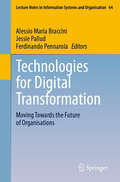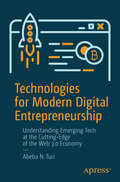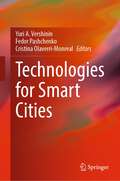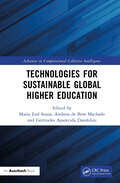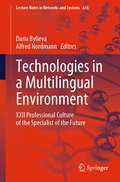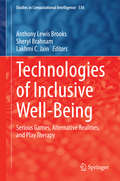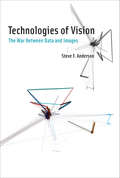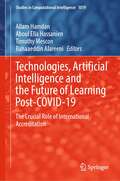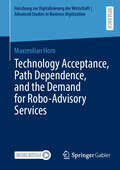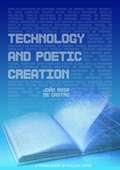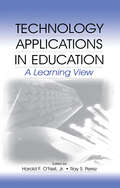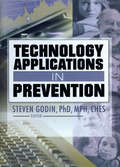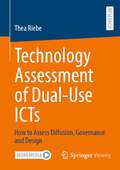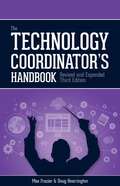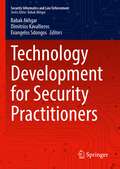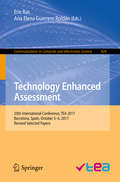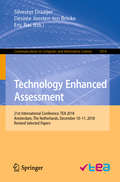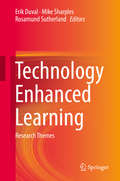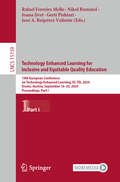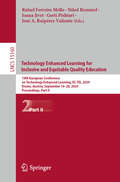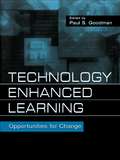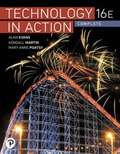- Table View
- List View
Technologies for Digital Transformation: Moving Towards the Future of Organisations (Lecture Notes in Information Systems and Organisation #64)
by Ferdinando Pennarola Alessio Maria Braccini Jessie PalludDigital technologies can have a profound impact on modern organisations, changing the way they operate, communicate, cooperate, and deliver value to stakeholders. This book gathers the selected and revised best papers presented at the annual conference of the Italian Chapter of AIS, which took place in Catanzaro in October 2022. It offers a comprehensive overview of the impacts of emerging digital technologies, such as AI, machine learning, blockchain, and Industry 4.0, on organisations and industries. In this book, these digital technologies are explored in relation to the digital transformation process for business organisations and industries. It investigates how emerging technologies influence the digital transformation of diverse business organisations, pointing out research trajectories, implications, opportunities, and challenges. Covering a wide range of topics related to digital transformation, it offers valuable insights into the latest research on the opportunities and challenges that accompany emerging digital technologies.
Technologies for Fingermark Age Estimations: A Step Forward
by Josep De Alcaraz-FossoulThis book discusses new applications of technologies that have been or could be successfully employed to estimate the age of fingermarks. Determining the specific time a fingermark is deposited could become a powerful new development in forensic science and a useful application to law enforcement. This book aims to shed some light on this important and still controversial area of scientific research. The expert chapters review recent discoveries and current developments with a practical bent, focusing on prospective uses in real-world crime scenes. They take a multidisciplinary approach, featuring contributors with diverse specialties including Chemistry, Imaging Technologies, Forensic Science, Biology and Microbiology. The balanced presentation incorporates critiques on fingermark aging studies, explores the reliability of fingermarks as evidence, and discusses how the estimation of “age” can improve robustness of crime evidence. Each chapter describes a unique aspect of fingermark aging observed from a different analytical perspective: 2D imaging; 3D imaging; chemical analysis; chemical imaging; microbiome analysis; electrochemical analysis; and DNA analysis, as well as the role and application of statistics. Illustrations and graphs aid the reader in understanding the concepts being explained. Not just a compilation of techniques and methods, this book’s emphasis on practical applications and its easy-to-read style will appeal to a broad audience of scientists and criminal justice professionals alike. It will be of great interest to law enforcement, academia, and the criminal justice community; including forensic scientists, investigators, lawyers, students, and researchers. It aims to help facilitate debates in the broader community about the feasibility, convenience, and relevance of estimating the age of evidence.
Technologies for Modern Digital Entrepreneurship: Understanding Emerging Tech at the Cutting-Edge of the Web 3.0 Economy
by Abeba N. TuriEmerging technologies offer a plethora of unprecedented opportunities for entrepreneurs in the digital space. Understanding this evolution is essential for web-based business models to succeed. The Web 3.0 economy is here, and this book has arrived to serve as your guide.Technologies for Modern Digital Entrepreneurship is an in-depth look at the new developments of the digital economic system. Cryptocurrencies, Central Bank Digital Currencies, and Stable Coins are explained through timely case studies, as well as innovations in crowdfunding, educational marketplaces, and scalability in blockchain-based transactions. Author Dr. Abeba N. Turi expertly navigates the industry transition from platform-based centralized Web 2.0 economy to the distributed network economy. Turi additionally explores trust and reputation as currency in the digital economy and allays common fears in digital entrepreneurship such as mistrust by investors and intellectual property loss.Avoid falling behind your competitors in the Wild West that is modern digital entrepreneurship. Whether you are a business leader, a technology enthusiast, or a researcher in the field, Technologies for Modern Digital Entrepreneurship gives you the advantage of insightful knowledge using real data and meaningful examples. Amid global regulatory changes and the ever-shifting methods of digital entrepreneurship, our modern era demands this book. What You Will Learn Discover new trends in the digital economic systemComprehend the crowd-based digital business modelsAnalyze the distributed information network economyUnderstand the workings of the currency system under the Web 3.0 economy, including Cryptocurrencies, Central Bank Digital Currencies, and Stable CoinsWho This Book Is ForTechnology enthusiasts, tech and interdisciplinary students, digital business leaders, and researchers in the field
Technologies for Smart Cities
by Yuri A. Vershinin Fedor Pashchenko Cristina Olaverri-MonrealThis book gives readers an overview about technologies that are useful for developments related to Smart Cities.Some technologies are already available, such for example, as smart meters for electricity and gas in buildings. But there are possibilities to incorporate existing devices into wider networks with other smart devices that currently operate independently. This in turn will considerably improve the reduction of the energy consumption in buildings, reduction of emission pollutions in cities and improvement of the well-being of people. The other objective of this book is to introduce readers to new technologies which are not yet implemented in areas related to the efficient functioning of cities. For example, areas related to Intelligent Transport Systems are mostly developed for the optimization of the traffic flow, reduction of accidents on roads, improvement of the safety of drivers and related to road transportation problems. The rapid advances in Blockchain technologies are also covered.
Technologies for Sustainable Global Higher Education (Advances in Computational Collective Intelligence)
by Maria José Sousa Andreia de Bem Machado Gertrudes Aparecida DandoliniDigital technologies are influencing the way we learn, live, work, and exist in different contexts of society in the digital age. There are a variety of learning systems that support innovative digital approaches, and universities and organizations around the world are investing in building their own e-learning platforms. Digital technologies are enabling wider access to education and new markets for student recruitment, resulting in increased income prospects for global higher education institutions. Technology enables numerous data and information sources, which give greater access to information and data. It also enables highly virtual environments, which impact teaching and the classroom. The widespread use and application of digital technologies in the teaching and learning process provoke pedagogical inquiry and mediation. It is in this context that Technologies for Sustainable Global Higher Education focuses on analyzing the application of digital technologies in the teaching–learning process. The chapters in this edited collection seek to answer questions relevant to the context of higher education, such as: What is the concept of digital technologies? How is digital technology used to mediate the learning process? What technologies are used to qualify education in higher education? This book provides answers to these questions by focusing on issues central to improving education through digital technologies, digital learning, and pedagogical practices in digital education. It also provides case studies of higher education institutions.
Technologies in a Multilingual Environment: XXII Professional Culture of the Specialist of the Future (Lecture Notes in Networks and Systems #636)
by Alfred Nordmann Daria BylievaThe book addresses the challenge of living in a multilingual world from three perspectives: socio-linguistics and the study of multilingualism in contrast, philosophy of technology with its emphasis on the world as a technosphere—how it is made, how it is experienced, and how it can be managed, and then pedagogy and the question of teaching and learning to competently negotiate multilingual environments. In today‘s multicultural and multilingual world, technologies provide a common ground. The story of the technosphere as a multilingual environment offers new perspective, namely that of learning to cooperate and coordinate.
Technologies of Inclusive Well-Being
by Lakhmi C. Jain Anthony Lewis Brooks Sheryl BrahnamThis book is the first single volume that brings together the topics of serious games, alternative realities, and play therapy. The focus is on the use of digital media for the therapeutic benefit and well-being of a wide range of people−spanning those with special needs to the elderly to entire urban neighborhoods. This book brings together these topics to demonstrate the increasing trans/inter/multi-disciplinary initiatives apparent today in science, medicine, and academic research−interdisciplinary initiative that are already profoundly impacting society
Technologies of Vision: The War Between Data and Images (The\mit Press Ser.)
by Steve F AndersonAn investigation of the computational turn in visual culture, centered on the entangled politics and pleasures of data and images.If the twentieth century was tyrannized by images, then the twenty-first is ruled by data. In Technologies of Vision, Steve Anderson argues that visual culture and the methods developed to study it have much to teach us about today's digital culture; but first we must examine the historically entangled relationship between data and images. Anderson starts from the supposition that there is no great divide separating pre- and post-digital culture. Rather than creating an insular field of new and inaccessible discourse, he argues, it is more productive to imagine that studying “the digital” is coextensive with critical models—especially the politics of seeing and knowing—developed for understanding “the visual.”Anderson's investigation takes on an eclectic array of examples ranging from virtual reality, culture analytics, and software art to technologies for computer vision, face recognition, and photogrammetry. Mixing media archaeology with software studies, Anderson mines the history of technology for insight into both the politics of data and the pleasures of algorithms. He proposes a taxonomy of modes that describe the functional relationship between data and images in the domains of space, surveillance and data visualization. At stake in all three are tensions between the totalizing logic of data and the unruly chaos of images.
Technologies of the Gendered Body: Reading Cyborg Women
by Anne BalsamoThis book takes the process of "reading the body" into the fields at the forefront of culture--the vast spaces mapped by science and technology--to show that the body in high-tech is as gendered as ever. From female body building to virtual reality, from cosmetic surgery to cyberpunk, from reproductive medicine to public health policies to TV science programs, Anne Balsamo articulates the key issues concerning the status of the body for feminist cultural studies in a postmodern world. Technologies of the Gendered Body combines close readings of popular texts--such as Margaret Atwood's novel The Handmaid's Tale, the movie Pumping Iron II: The Women, cyberpunk magazines, and mass media--with analyses of medical literature, public policy documents, and specific technological practices. Balsamo describes the ways in which certain biotechnologies are ideologically shaped by gender considerations and other beliefs about race, physical abilities, and economic and legal status. She presents a view of the conceptual system that structures individuals access to and participation in these technologies, as well as an overview of individuals rights and responsibilities in this sometimes baffling area. Examining the ways in which the body is gendered in its interactions with new technologies of corporeality, Technologies of the Gendered Body counters the claim that in our scientific culture the material body has become obsolete. With ample evidence that the techno-body is always gendered and marked by race, this book sets the stage for a renewed feminist engagement with contemporary technological narratives.
Technologies of the New Real: Viral Contagion and Death of the Social (Digital Futures)
by Arthur Kroker Marilouise KrokerWith astonishing speed, we have been projected into a new reality where interactions with drones, robotic bodies, and high-level surveillance are increasingly mainstream. In this age of groundbreaking developments in robotic technologies, synthetic biology is merging with artificial intelligence, forming a newly blended reality of machines, bodies, and affect. Technologies of the New Real draws from critical intersections of technology and society – including drones, surveillance, DIY bodies, and innovations in robotic technology – to explore what these advances can tell us about our present reality, or what authors Arthur and Marilouise Kroker deem the "new real" of digital culture in the twenty-first century. Technologies of the New Real explores the many technologies of our present reality as they infiltrate the social, political, and economic static of our everyday lives, seemingly eroding traditionally conceived boundaries between humans and machines, and rendering fully ambivalent borders between the human mind and simulated data.
Technologies, Artificial Intelligence and the Future of Learning Post-COVID-19: The Crucial Role of International Accreditation (Studies in Computational Intelligence #1019)
by Aboul Ella Hassanien Timothy Mescon Allam Hamdan Bahaaeddin AlareeniThis book aims to assess the experience of education during COVID-19 pandemic and explore the future of application of technologies and artificial intelligence in education. Education delivery requires the support of new technologies such as artificial intelligence (AI), the Internet of Things (IoT), big data, and machine learning to fight and aspire to new diseases. The academic community and those interested in education agree that education after the corona pandemic will not be the same as before. The book also questions the role of accreditation bodies (e.g., AACSB, etc.) to ensure the effectiveness and efficiency of technology tools in achieving distinguished education in times of crisis.
Technology Acceptance, Path Dependence, and the Demand for Robo-Advisory Services (Forschung zur Digitalisierung der Wirtschaft | Advanced Studies in Business Digitization)
by Maximilian HornThis book explores the effects of the previously ignored factors of path dependence and product features on technology acceptance with a focus on robo-advice. A newly developed model introduces path dependence to technology acceptance research allowing to explain previously unaccountable effects. An empirical test of the model using data from Germany and the USA elicits that path dependence influences the attitudes towards and demand for robo-advice. A process consisting of a market survey, a choice-based conjoint analysis, and a test in a technology acceptance model allows the structured investigation of the effects of product features on the demand for robo-advice. The results show that selected product features have effects on the demand for robo-advice and that it is essential to establish these effects empirically.
Technology And Poetic Creation
by João Rosa de CastroAn attempt to answer the question of scientific initiation: "can technological instruments change the meaning of poet and poetry?" Technology and poetic creation The objective of this work is to present, as much as possible, the network of relationships of technology and poetic composition, and was proposed in the Scientific Initiation program of the CCHSAE (Center for Human and Social Sciences, Arts and Education) at the Cruzeiro do Sul University, in 2003. Although these relations seem recent, due to the growing development of technologies, in the 20th century, the conclusions demonstrate that technology has always been present, in some way, as an extension of human activities. This indisputable presence starts from the need for technology for Education, Health and Politics, as a factor of social and digital inclusion, from the pencil, through the technological resources in the processes of artistic and cultural production, such as, for example, holography, reaching the electronic literary hypertext, where it finds its peak in Literature. The method of this research is predominantly inductive, with the characterization of facts and the establishment of principles and concepts, in the relations of individuals with technological instruments to improve the quality of poetic creation. The result is the deconstruction of oppositions, such as art x technology, technology x sensitivity, technology x creation; in a perception of how technological instruments, used in a coherent way, that is, as an extension of human action, and not the other way around, can be prime for the transformation of paradigms in the interpretation of reality or in the composition of their portraits. It is concluded, therefore, that despite this extension, often controversial, as it may suggest inertia itself, it is still up to humanity, being composed of cooperative individuals, regardless of the technological resources at hand, their socio-cultural impro
Technology Applications in Education: A Learning View
by Ray S. Perez Harold F. O'NeilThis volume identifies promising learning, teaching, and assessment strategies for the use and assessment of technology in educational settings, specifically: *educational context (e.g., organizational and structural factors that contribute to the effective use of technology in school settings); *promising learning and teaching strategies; *promising technology-based assessment procedures and methods; *policy implementation issues; and *a summary of current research on the effective use of technology in education. Chapter authors represent a variety of perspectives and disciplines, from computer science, cognitive and educational psychology, and educational administration. Authors represent government, business, and university communities from within and outside the U.S. These multiple perspectives contribute to the overall understanding of current technology use in education and help in identifying future research needs. Technology Applications in Education: A Learning View explores the state of the art of technology in K-16 education from a learning perspective rather than a hardware/software view. It is designed for professionals and graduate students in the educational technology, training, assessment/evaluation, school administration, military psychology, and educational psychology communities. This book is characterized in the following montage of factors: *the primacy of learning as a focus for technology implementation; *a focus on technology uses in K-16 education; *a focus on the assessment of both individuals and teams; *a broad variety of methodological approaches from qualitative to instructional design to quantitative (e.g., structural equation modeling); *a need to support the development of technology-based curriculum and tools; and *a need for theory-driven and evaluation studies to increase our knowledge.
Technology Applications in Prevention
by Steven GodinControl health care costs with these cost-effective, technology-based prevention/intervention techniques!In 2001, Americans spent $1.4 trillion on health care services. By 2010, health care costs are forecasted to approach 20% of the United States&’ Gross National Product. Technology Applications in Prevention highlights much-needed technology-based prevention/intervention methods that can help contain health costs. "Efficient and Effective Uses of Technology in Community Research" provides the information that future prevention researchers and program evaluators will need to be effective in electronic data collection, management, and cost analysis. "Community Building with Technology: The Development of Collaborative Community Technology Initiatives" presents a case example showing how Web sites can function as regional clearinghouses of useful information and provide convenient forums where agency staff can update their prevention skills. "Applying Web-Based Survey Design Standards" addresses a question critical to professionals in e-data collection: How reliable is Web-based needs assessment and/or outcome data? This chapter suggests standards that should be adhered to in Internet-based data collection. "Assessing Quality Assurance of Self-Help Sites on the Internet" and "The Quality of Spanish Health Information Web Sites: An Emerging Disparity" address the current lack of quality in the health and mental health information available on the World Wide Web. "A Participatory Internet Initiative in an African-American Neighborhood" explores health disparity concerns regarding the use of the Internet. This chapter discusses several ways to empower those who are on the dark side of the "digital divide"-and shows how to ensure that Web-based material is culturally relevant and appropriate for those it is intended to help. "Alcohol Abuse Prevention Among High-Risk Youth" presents a case example of a life-skills based CD-ROM intervention designed to discourage kids from abusing alcohol. "Constructing Better Futures Via Video" looks at video-based futures planning, which combines self-modeling and "feedforward" to forecast a student&’s future capabilities. This technique helps teenagers find meaning in their current educational setting and prepare for adulthood. This chapter also explains how to train school-based personnel to encourage positive attitudes and support the life skills of their students via carefully planned and edited-yet inexpensive-video productions.Why is the information in this book so essential? In 2000, approximately 20% of U.S. employers changed their health insurance plans as a cost savings strategy. American companies and their employees must new deal with new insurance plans that have reduced the breadth of their coverage and/or increased employee deductibles. The need for cost-effective preventive strategies is becoming increasingly more urgent as employers and insurance companies scramble to provide affordable health care coverage. New technologies have opened the door to better, more economical modes of preventive care. This book presents a vital cross-section of the current state of the art in the application of technology to prevention and intervention. Make it a part of your professional/teaching collection today!
Technology Assessment of Dual-Use ICTs: How to Assess Diffusion, Governance and Design
by Thea RiebeInformation and Communication Technologies (ICTs) are important to human, national, and even international security. IT research, artifacts, and knowledge that can be applied in military and civilian contexts, used as part of weapon systems, or cause significant harm are referred to as dual-use. Advances in artificial intelligence (AI), robotics, cybersecurity, and open source intelligence (OSINT) raise questions about their dual-use risks. But how can dual-use of such disparate technologies be assessed? Case studies are still lacking on how to assess dual-use ICT and how to enable sensitive and responsible dual-use design. To address the research gap, this cumulative dissertation uses Technology Assessment (TA) as an epistemological framework to bring together approaches of Critical Security Studies (CSS) as well as Value Sensitive Design (VSD) from the field of Human-Computer Interaction (HCI). As a result, the dissertation systematizes the dual-use risks and scenarios of the selected ICTs and derives organizational and design implications.
Technology Coordinator's Handbook, 3rd Edition
by Max Frasier Doug HearringtonThis handbook is designed to help technology coordinators become more effective learners and leaders so they can better assist students, teachers and administrators in the use of tech devices and resources. The technology coordinator can be seen as the orchestrator in the school or district, able to balance technology policies and procedures with device-specific requirements, locate funding and support, and facilitate ongoing training and support. In a time when technology is constantly changing, the technology coordinator adapts and stays abreast of the latest developments.This handbook is designed to help technology coordinators become more effective learners and leaders so they can better assist students, teachers and administrators in the use of tech devices and resources. The technology coordinator can be seen as the orchestrator in the school or district, able to balance technology policies and procedures with device-specific requirements, locate funding and support, and facilitate ongoing training and support. In a time when technology is constantly changing, the technology coordinator adapts and stays abreast of the latest developments. In this new edition of the highly respected Technology Coordinator’s Handbook, Max Frazier and co-author Doug Hearrington expand the scope of this practical guide to include New processes for technical support and technology lifecycle management. Considerations for BYOD programs. Practical advice on the implementation of cloud computing services. Profiles and job descriptions of technology coordinators and district leaders. Readers of this book — whether they are technology coordinators, teacher educators or administrators — will come away with a 360-degree view of the technology coordinator’s role and a new appreciation for teaching and learning with technology.
Technology Development for Security Practitioners (Security Informatics and Law Enforcement)
by Babak Akhgar Dimitrios Kavallieros Evangelos SdongosThis volume is authored by a mix of global contributors from across the landscape of academia, research institutions, police organizations, and experts in security policy and private industry to address some of the most contemporary challenges within the global security domain. The latter includes protection of critical infrastructures (CI), counter-terrorism, application of dark web, and analysis of a large volume of artificial intelligence data, cybercrime, serious and organised crime, border surveillance, and management of disasters and crises. This title explores various application scenarios of advanced ICT in the context of cybercrime, border security and crisis management, serious and organised crime, and protection of critical infrastructures. Readers will benefit from lessons learned from more than 30 large R&D projects within a security context. The book addresses not only theoretical narratives pertinent to the subject but also identifies current challenges and emerging security threats, provides analysis of operational capability gaps, and includes real-world applied solutions.Chapter 11 is available open access under a Creative Commons Attribution 3.0 IGO License via link.springer.com.
Technology Enhanced Assessment: 20th International Conference, Tea 2017, October 5-6, 2017, Barcelona, Spain (Communications In Computer And Information Science #829)
by Eric Ras Ana Elena Guerrero RoldánThis book constitutes the proceedings of the 20th International Conference on Technology Enhanced Assessment, TEA 2017, held in Barcelona, Spain, in October 2017. The 17 papers presented were carefully selected from 42 submissions. They are centered around topics like e-learning, computer-assisted instruction, interactive learning environments, collaborative learning, computing education, student assessment.Chapter "Student perception of scalable peer-feedback design in Massive Open Online Courses" is licensed under the terms of the Creative Commons Attribution 4.0 International License (http://creativecommons.org/licenses/by/4.0/). For further details see license information in the chapter.
Technology Enhanced Assessment: 21st International Conference, TEA 2018, Amsterdam, The Netherlands, December 10–11, 2018, Revised Selected Papers (Communications in Computer and Information Science #1014)
by Desirée Joosten-ten Brinke Eric Ras Silvester DraaijerThis book constitutes the proceedings of the 21st International Conference on Technology Enhanced Assessment, TEA 2018, held in Amsterdam, The Netherlands, in December 2018. The 14 papers presented were carefully selected from 34 submissions. They are centered around topics like e-learning, computer-assisted instruction, interactive learning environments, collaborative learning, computing education, student assessment.
Technology Enhanced Learning
by Erik Duval Rosamund Sutherland Mike SharplesThis book provides an overview of the state-of-the-art in Technology Enhanced Learning (TEL). It is organized as a collection of 21 clusters or research themes, each introduced by leading experts and including references to the most relevant literature on the theme of each cluster. Additionally, four seminal papers on each theme are included with expert commentaries and updates. This volume is of high value to the TEL community, a large and active group of multidisciplinary researchers, to contextualize the field and define it as a distinct research area.
Technology Enhanced Learning for Inclusive and Equitable Quality Education: 19th European Conference on Technology Enhanced Learning, EC-TEL 2024, Krems, Austria, September 16–20, 2024, Proceedings, Part I (Lecture Notes in Computer Science #15159)
by Ioana Jivet Rafael Ferreira Mello Nikol Rummel Gerti Pishtari José A. Ruipérez ValienteThe two-volume set LNCS 15159 and 15160 constitutes the proceedings of 19th European Conference on Technology Enhanced Learning, EC-TEL 2024, which took place in Krems, Austria, in September 2024. The 37 full papers, 25 poster papers, and 10 demo papers presented in the proceedings were carefully reviewed and selected from 140 submissions for research papers, and 26 poster and 19 demo submissions. They focus on effective technology adoption in educational settings, ethical concerns, and the possible digital divide these technologies could create. The theme for the 2024 conference aimed to explore the role of Technology-Enhanced Learning (TEL) in this critical context and in achieving the United Nations’ Sustainable Development Goal for education: “Ensure inclusive and equitable quality education and promote lifelong learning opportunities for all.”
Technology Enhanced Learning for Inclusive and Equitable Quality Education: 19th European Conference on Technology Enhanced Learning, EC-TEL 2024, Krems, Austria, September 16–20, 2024, Proceedings, Part II (Lecture Notes in Computer Science #15160)
by Ioana Jivet Rafael Ferreira Mello Nikol Rummel Gerti Pishtari José A. Ruipérez ValienteThe two-volume set LNCS 15159 and 15160 constitutes the proceedings of 19th European Conference on Technology Enhanced Learning, EC-TEL 2024, which took place in Krems, Austria, in September 2024. The 37 full papers, 25 poster papers, and 10 demo papers presented in the proceedings were carefully reviewed and selected from 140 submissions for research papers, and 26 poster and 19 demo submissions. They focus on effective technology adoption in educational settings, ethical concerns, and the possible digital divide these technologies could create. The theme for the 2024 conference aimed to explore the role of Technology-Enhanced Learning (TEL) in this critical context and in achieving the United Nations’ Sustainable Development Goal for education: “Ensure inclusive and equitable quality education and promote lifelong learning opportunities for all.”
Technology Enhanced Learning: Opportunities for Change
by Paul S. GoodmanThis book focuses on how technology may create new learning environments and enhance basic learning processes. The book identifies and informs some of the strategic decisions involved in designing and implementing new technology to enhance learning. It also examines specific learning applications of TEL in order to understand the context of different learning environments, as well as some of the critical lessons learned in designing these environments. Mixing both conceptual perspectives and actual case experiences should create different learning opportunities for the reader. Technology Enhanced Learning is divided into two parts. Part I deals with strategic issues, such as trends in technology, implications for educational systems, designing infrastructure, and learning environments. Part II looks at specific cases of new learning environments to learn about strategy, infrastructure, impact assessment, and change in TEL learning environments.
Technology In Action Complete
by Alan Evans Kendall Martin Mary PoatsyTechnology in Action Complete uses practical content and hands-¿on projects to engage students in computing tasks and skills they can apply at work, in class, or at home. Designed for today's technically savvy students, the text introduces difficult concepts at a basic level early on, then expands upon these skills as students build mastery. The 16th edition further emphasizes the importance of digital literacy with two new Try This projects
